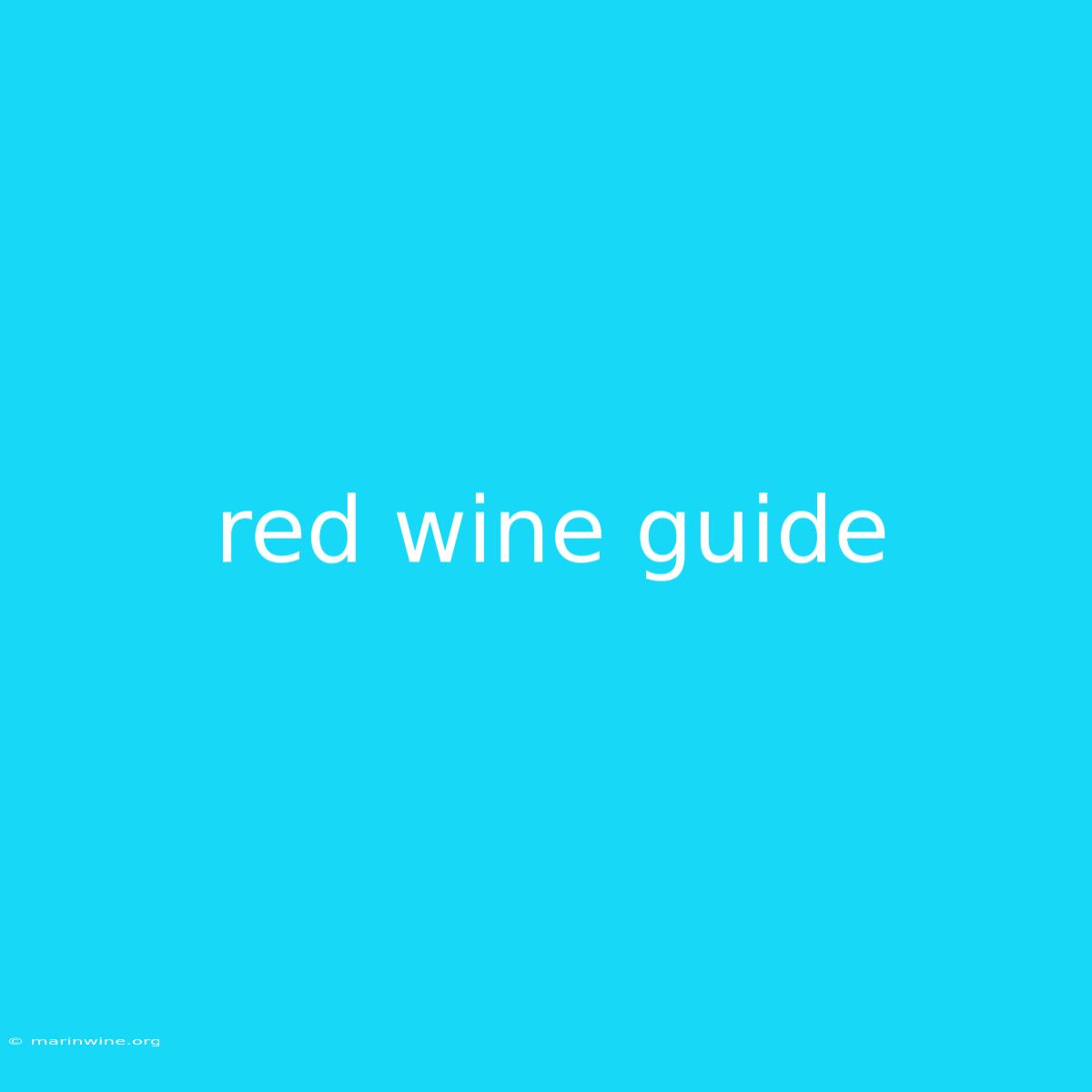Uncorking the World of Red Wine: A Comprehensive Guide
Have you ever wondered what makes a good red wine, or how to choose the perfect bottle for your next dinner party? The world of red wine is vast and exciting, offering a spectrum of flavors, aromas, and experiences. This guide will equip you with the knowledge to navigate this wonderful world, uncovering the secrets of red wine and empowering you to become a confident connoisseur.
Why This Matters
Understanding red wine goes beyond simply enjoying a glass. It opens doors to a world of cultural heritage, culinary pairings, and sophisticated enjoyment. This guide will demystify the process, covering everything from grape varietals to winemaking techniques, allowing you to appreciate the nuances of this beloved beverage.
Key Takeaways
| Key Takeaway | Description |
|---|---|
| Grape Varietals | Understanding the different grape varietals and their unique characteristics is crucial for selecting wines you'll enjoy. |
| Winemaking Techniques | Winemaking methods directly impact the final flavor profile of the wine. Understanding these techniques helps you appreciate the variations you encounter. |
| Wine Regions | Geographical factors play a vital role in the flavor and quality of wines. Familiarizing yourself with different wine regions and their specific terroir allows you to explore a wider range of red wines. |
| Tasting and Pairing | Knowing how to taste and evaluate red wines helps you appreciate their subtleties and makes pairing them with food a delightful experience. |
Red Wine: A Deeper Dive
Understanding Grape Varietals
Red wine is made from a diverse range of grape varietals, each with its own unique characteristics. Knowing the different grapes allows you to anticipate the flavors and aromas you'll encounter.
Key Varietals to Know:
- Cabernet Sauvignon: Known for its bold, full-bodied flavors, often featuring blackcurrant, cedar, and earthy notes.
- Merlot: Offers a softer, more approachable profile, with notes of plum, cherry, and sometimes chocolate.
- Pinot Noir: This delicate grape produces light-bodied wines with earthy, floral, and often cherry-like notes.
- Syrah/Shiraz: Known for its intense dark fruit flavors, spice notes, and occasionally a peppery finish.
- Zinfandel: Offers a range of styles, from fruity and jammy to spicy and peppery, often with notes of blackberries and raspberries.
Winemaking Techniques
Winemaking techniques play a significant role in shaping the final character of the wine.
Key Techniques:
- Fermentation: This process transforms grape sugars into alcohol. Red wine fermentation occurs with the grape skins, imparting color and tannins.
- Aging: Wines are often aged in oak barrels, which contribute flavor and complexity.
- Blending: Many red wines are blends, where different grape varietals are combined to create a more complex and balanced flavor profile.
Wine Regions
The unique environment of a wine region, referred to as "terroir," significantly influences the grape's growth and the final wine's character.
World-Renowned Red Wine Regions:
- Bordeaux, France: Known for its Cabernet Sauvignon and Merlot blends, producing powerful and structured wines.
- Burgundy, France: Famous for its Pinot Noir and Chardonnay, offering elegant and complex wines.
- Italy: Offers a vast range of red wines, from light-bodied Chianti to full-bodied Barolo.
- California, USA: Renowned for its Zinfandel and Cabernet Sauvignon, showcasing fruit-forward and powerful wines.
- Australia: Known for its Shiraz, producing bold and spicy wines.
Tasting and Pairing
Tasting red wine involves engaging all your senses, allowing you to appreciate its nuances.
Tasting Tips:
- Appearance: Observe the wine's color and clarity.
- Aroma: Inhale deeply to appreciate the bouquet, identifying fruits, spices, or floral notes.
- Taste: Roll the wine around your mouth to experience the flavors, including sweetness, acidity, tannins, and alcohol.
- Finish: Note the lingering flavors and their duration on your palate.
Food Pairing Recommendations:
- Cabernet Sauvignon: Pairs well with red meats, grilled lamb, hearty stews, and aged cheeses.
- Merlot: Complements lighter meats, roasted vegetables, and pasta dishes.
- Pinot Noir: Ideal with salmon, duck, mushroom dishes, and delicate cheeses.
- Syrah/Shiraz: Enhances roasted meats, spicy food, and hearty stews.
- Zinfandel: Complements BBQ ribs, burgers, and spicy dishes.
FAQ: Red Wine
Q: What is the difference between a dry and sweet red wine? A: Dry red wines have little to no residual sugar, while sweet red wines have a noticeable sweetness.
Q: What are tannins? A: Tannins are compounds found in grape skins and seeds that provide astringency and bitterness to red wines.
Q: How long should I age red wine? A: Some red wines benefit from aging, becoming smoother and more complex. Others are best enjoyed young. Look for recommendations on the bottle's label.
Q: How do I store red wine? A: Store red wine in a cool, dark place, ideally at a temperature between 50-55°F.
Q: Can I drink red wine every day? A: Moderate consumption of red wine may offer some health benefits, but excessive consumption can be harmful.
Tips for Enjoying Red Wine
- Choose the right glass: Use a wide-bowled glass, like a Bordeaux or Burgundy glass, to allow the wine to breathe and enhance its aromas.
- Decant: Some red wines benefit from decanting, which allows the wine to aerate and soften its tannins.
- Serve at the right temperature: Red wines are typically served at room temperature, which is around 65°F.
- Don't be afraid to experiment: Try different varietals and regions to discover new favorites.
Summary: Uncorking the World of Red Wine
This guide has explored the multifaceted world of red wine, empowering you to approach this beverage with confidence and appreciation. From understanding grape varietals to exploring different regions and tasting techniques, you're now equipped to embark on a flavorful journey of discovery. As you explore the vast world of red wines, remember to savor each sip and embrace the richness and complexity that every bottle offers.

